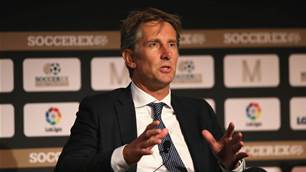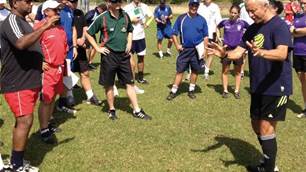Australia’s national youth development system is fractured, lacking direction and, say its critics, run for the wrong reasons. Yet there is a ray of hope.
Page 2 of 3 | Single page
A few kilometres from IQ is the HQ of Football NSW, whose head of high performance is Paul Bentvelzen. “Our mission statement in the high performance unit,” he says earnestly, “is to be the premier development program in the country.”
Bentvelzen says he judges the success of the NSW program “on the number of players that play for the country and how we go against the rest of the states.”
He adds with pride that “our U13s metro boys and girls haven’t lost a game yet. Our technical staff will then look at these results to see how far ahead we are of the other states. Our country teams haven’t been doing as well as our city teams, so we want to try and increase the standard of country football.”
Football NSW is arguably the most powerful federation in the country, cashed up thanks to massive player numbers and with land inherited from the late Charlie Valentine, enabling it to build impressive training facilities, HQ and accommodation near Blacktown, an hour’s drive from Sydney.
Football NSW uses Coerver coaching as part of its grassroots coaching program for seven to 10-year-olds.
“It’s been very successful across the whole state,” argues Bentvelzen. “It’s a technical based program that we can sell to mums and dads with confidence. After the seven to 10 age, we move into programs that focus on technical awareness and by 13, tactical awareness,” he adds, spreadsheets at the.
“We have goal-setting for young players as part of our home training program, where we get them to think about certain areas of their game, because it’s hard to assess young players. It’s got to come down to internal motivation.” Bentvelzen says that players do have to pay to play in state teams “but we do have a hardship fund, although that is difficult to apply to everyone.” Coerver sessions cost about $15 and Bentvelzen says anything from 40 to 100 sessions could be paid for. Overseas tours cost between $2000 and $5500.
One man with serious youth coaching credentials is Ange Postecoglou. He famously was involved in a slanging match with SBS’s football analyst Craig Foster last year concerning the state of the nation’s youth development. It was compelling viewing but also highlights the passion that this debate has stirred up over recent years.
Postecoglou was national U17 and U20 coach for seven years up until the beginning of this year when the FFA passed on renewing his contract. He’s not impressed with state federations hanging their hat on numbers rather than quality.
“Is it right?” he asks. “No it isn’t. So I’ll put it back onto them – your brief should be to produce better players each year rather than produce more numbers for the national team. I’d rather have one from NSW than 10 if it means the quality’s there.”
Postecoglou also notes the anomaly in the system that favours junior players who physically develop faster than others. “They get all the benefits of the best coaches and are separated from other kids, but once they get to 16 or 17 many are found out to be lacking in technical attributes. Perhaps some of the less physically big kids had more technical ability but were left behind.
“I’ve spent a lot of time in Clarefontaine [France’s national centre of excellence], and the first test of incoming players is juggling with both left and right. It’s an identification of a basic skill and if they don’t have that it’s not what they need from players.”
Australia youth development has some unique challenges. As a nation, we are geographically isolated from world football’s hotspots, have a relatively small population and football must compete with three other codes for raw talent, money, corporate sponsorship and media attention.
It’s a tough gig from the get-go for our football producers. Within this social-sporting context, the Australian football youth development system doesn’t operate collectively. In football terms, it’s like a team with players who each want to play for themselves. It doesn’t make for a productive national youth development system.
Football Federation Australia (FFA) runs the game at a national level but hasn’t yet put its imprint on a national approach to youth development.
Beneath this, the various state federations and elite state-based institutes run their own youth programs and set their own direction. For instance, NSW is the licensee of Coerver coaching for Australia and Oceania. The VIS already uses elements of Coerver but it doesn’t base its whole training on it.
Some states judge their success on numbers of players they get into state and national teams, while others judge it on the level of technical ability of the players they produce. And there is only a minimal level of information sharing between the states’ peak bodies.
Alongside state bodies are academies – such as the VIS, NSWIS and QAS. These elite organisations have varying degrees of partnerships with the state-run bodies.
Then there are the clubs. Most A-League clubs don’t have formal youth structures as we’d know in Europe [see boxout “Central Coast youth vision”, page 50], although the teams are mandated to include three U20 players in a 23-man squad.
At the base of the youth development system is what is powering the game: Australian kids love football. Boys and girls play the sport in record numbers; it’s the fastest growing participation sport for girls too. It also means football at junior level is big business.
At the top end of the youth development chain is the Australian Institute of Sport (AIS) whose head coach is former Socceroo Steve O’Connor. He tells FourFourTwo that the technical level of the players arriving at the AIS “is well behind all major football countries. What’s more, we only have nine months each year to get them ready for qualifiers in Asia in October.”
Which brings us to the black hole of Australian football. Australia hasn’t had a national youth league for three years. While the architects of the new A-League have done a fine job of revitalising the senior competition, the kids have been left outside the house – and they’ve been homeless for way too long.
If there is one thing all those who FourFourTwo spoke to agreed on, it was the destructive effect this is having.
“It is a black hole… a huge black hole,” says Ian Greener, who runs the football program at the Victorian Institute of Sport.
Postecoglou describes it as “disastrous”. “In 2004/05, we didn’t even have an NSL. We came back from the 2003 World Youth Championships having beaten Brazil, and many of the squad came back to play state league football – having just beaten Brazil!”
According to insiders, a national youth league is on the FFA’s radar, but when exactly, no-one is quite sure. One insider tells us, “It’s all about money, [but we] don’t know when it’s going to happen though.”
As a work-around, the AIS football team was admitted to the Victorian Foxtel Cup. Frustratingly, the AIS – based in Canberra – has not been able to play in the nearer NSW Premier League. Why this is so remains a mystery to most, including O’Connor.
In fact, he’s scathing of NSW’s long-standing refusal to bring the AIS into its Premier League, while the extra cost of playing in Victoria comes out of his own AIS budget. This funding issue is putting in doubt continued participation in the Foxtel Cup venture. “It’s been beneficial, no doubt, to have the guys play against seniors and regularly,” says O’Connor ruefully.
Step back to 2003/04 and, ironically, the old National Soccer League assisted the development of a number of our most talented younger players. By that final season, many NSL clubs were so broke that teenagers were thrown into the first team. It didn’t hurt their progress.
Victory stars Daniel Piorkowski and Adrian Leijer (now at Fulham) anchored the Melbourne Knights defence, Alex Brosque broke in at Marconi as did Adam Kwasnik at Spirit, while South Melbourne’s Kristian Sarkies was given his chance, as was Jet Tarek Elrich at Olympic.
In 2007, A-League U20s will find it much tougher to play regular football in the seniors. But unlike the old NSL, there is no regular summer youth league to play in.
It’s no wonder so many youngsters chance their arm overseas.
Bentvelzen says he judges the success of the NSW program “on the number of players that play for the country and how we go against the rest of the states.”
He adds with pride that “our U13s metro boys and girls haven’t lost a game yet. Our technical staff will then look at these results to see how far ahead we are of the other states. Our country teams haven’t been doing as well as our city teams, so we want to try and increase the standard of country football.”
Football NSW is arguably the most powerful federation in the country, cashed up thanks to massive player numbers and with land inherited from the late Charlie Valentine, enabling it to build impressive training facilities, HQ and accommodation near Blacktown, an hour’s drive from Sydney.
Football NSW uses Coerver coaching as part of its grassroots coaching program for seven to 10-year-olds.
“It’s been very successful across the whole state,” argues Bentvelzen. “It’s a technical based program that we can sell to mums and dads with confidence. After the seven to 10 age, we move into programs that focus on technical awareness and by 13, tactical awareness,” he adds, spreadsheets at the.
“We have goal-setting for young players as part of our home training program, where we get them to think about certain areas of their game, because it’s hard to assess young players. It’s got to come down to internal motivation.” Bentvelzen says that players do have to pay to play in state teams “but we do have a hardship fund, although that is difficult to apply to everyone.” Coerver sessions cost about $15 and Bentvelzen says anything from 40 to 100 sessions could be paid for. Overseas tours cost between $2000 and $5500.
One man with serious youth coaching credentials is Ange Postecoglou. He famously was involved in a slanging match with SBS’s football analyst Craig Foster last year concerning the state of the nation’s youth development. It was compelling viewing but also highlights the passion that this debate has stirred up over recent years.
Postecoglou was national U17 and U20 coach for seven years up until the beginning of this year when the FFA passed on renewing his contract. He’s not impressed with state federations hanging their hat on numbers rather than quality.
“Is it right?” he asks. “No it isn’t. So I’ll put it back onto them – your brief should be to produce better players each year rather than produce more numbers for the national team. I’d rather have one from NSW than 10 if it means the quality’s there.”
Postecoglou also notes the anomaly in the system that favours junior players who physically develop faster than others. “They get all the benefits of the best coaches and are separated from other kids, but once they get to 16 or 17 many are found out to be lacking in technical attributes. Perhaps some of the less physically big kids had more technical ability but were left behind.
“I’ve spent a lot of time in Clarefontaine [France’s national centre of excellence], and the first test of incoming players is juggling with both left and right. It’s an identification of a basic skill and if they don’t have that it’s not what they need from players.”
Australia youth development has some unique challenges. As a nation, we are geographically isolated from world football’s hotspots, have a relatively small population and football must compete with three other codes for raw talent, money, corporate sponsorship and media attention.
It’s a tough gig from the get-go for our football producers. Within this social-sporting context, the Australian football youth development system doesn’t operate collectively. In football terms, it’s like a team with players who each want to play for themselves. It doesn’t make for a productive national youth development system.
Football Federation Australia (FFA) runs the game at a national level but hasn’t yet put its imprint on a national approach to youth development.
Beneath this, the various state federations and elite state-based institutes run their own youth programs and set their own direction. For instance, NSW is the licensee of Coerver coaching for Australia and Oceania. The VIS already uses elements of Coerver but it doesn’t base its whole training on it.
Some states judge their success on numbers of players they get into state and national teams, while others judge it on the level of technical ability of the players they produce. And there is only a minimal level of information sharing between the states’ peak bodies.
Alongside state bodies are academies – such as the VIS, NSWIS and QAS. These elite organisations have varying degrees of partnerships with the state-run bodies.
Then there are the clubs. Most A-League clubs don’t have formal youth structures as we’d know in Europe [see boxout “Central Coast youth vision”, page 50], although the teams are mandated to include three U20 players in a 23-man squad.
At the base of the youth development system is what is powering the game: Australian kids love football. Boys and girls play the sport in record numbers; it’s the fastest growing participation sport for girls too. It also means football at junior level is big business.
At the top end of the youth development chain is the Australian Institute of Sport (AIS) whose head coach is former Socceroo Steve O’Connor. He tells FourFourTwo that the technical level of the players arriving at the AIS “is well behind all major football countries. What’s more, we only have nine months each year to get them ready for qualifiers in Asia in October.”
Which brings us to the black hole of Australian football. Australia hasn’t had a national youth league for three years. While the architects of the new A-League have done a fine job of revitalising the senior competition, the kids have been left outside the house – and they’ve been homeless for way too long.
If there is one thing all those who FourFourTwo spoke to agreed on, it was the destructive effect this is having.
“It is a black hole… a huge black hole,” says Ian Greener, who runs the football program at the Victorian Institute of Sport.
Postecoglou describes it as “disastrous”. “In 2004/05, we didn’t even have an NSL. We came back from the 2003 World Youth Championships having beaten Brazil, and many of the squad came back to play state league football – having just beaten Brazil!”
According to insiders, a national youth league is on the FFA’s radar, but when exactly, no-one is quite sure. One insider tells us, “It’s all about money, [but we] don’t know when it’s going to happen though.”
As a work-around, the AIS football team was admitted to the Victorian Foxtel Cup. Frustratingly, the AIS – based in Canberra – has not been able to play in the nearer NSW Premier League. Why this is so remains a mystery to most, including O’Connor.
In fact, he’s scathing of NSW’s long-standing refusal to bring the AIS into its Premier League, while the extra cost of playing in Victoria comes out of his own AIS budget. This funding issue is putting in doubt continued participation in the Foxtel Cup venture. “It’s been beneficial, no doubt, to have the guys play against seniors and regularly,” says O’Connor ruefully.
Step back to 2003/04 and, ironically, the old National Soccer League assisted the development of a number of our most talented younger players. By that final season, many NSL clubs were so broke that teenagers were thrown into the first team. It didn’t hurt their progress.
Victory stars Daniel Piorkowski and Adrian Leijer (now at Fulham) anchored the Melbourne Knights defence, Alex Brosque broke in at Marconi as did Adam Kwasnik at Spirit, while South Melbourne’s Kristian Sarkies was given his chance, as was Jet Tarek Elrich at Olympic.
In 2007, A-League U20s will find it much tougher to play regular football in the seniors. But unlike the old NSL, there is no regular summer youth league to play in.
It’s no wonder so many youngsters chance their arm overseas.
Related Articles

Sydney FC and Ajax form youth partnership

Youth United disunited as splits emerge













